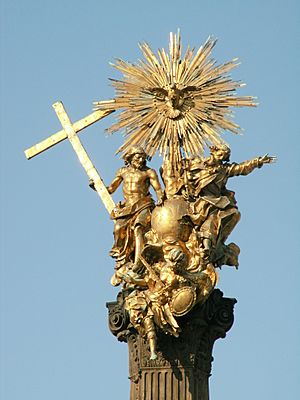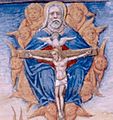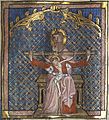Trinity facts for kids
In the Christian faith, the Trinity is a way to understand that God is seen as three different "persons" who are all the same God. These three are: God the Father, God the Son (who is Jesus), and God the Holy Spirit. Even though they are distinct, Christians believe they are all one God.
This idea is a very important core belief in Christian theology.
Contents
What Does the Word "Trinity" Mean?
The English word "Trinity" comes from the Latin word "Trinitas." This word means "the number three" or "a group of three." It's similar to how "unity" comes from "one."
In Greek, the word is "Τριάς" (Trias), which also means "a set of three."
One of the first times this Greek word was used in Christian writings was around 170 AD by Theophilus of Antioch. He wrote about God, His Word (Jesus), and His wisdom as a "Trinity."
Later, in the early 200s, a Latin writer named Tertullian was the first to use the words "Trinity," "person," and "substance." He used them to explain that the Father, Son, and Holy Spirit are "one in essence" but not "one in Person." This helped people understand how they could be distinct yet united.
The Council of Nicaea and the Trinity
About a century later, in 325 AD, an important meeting called the First Council of Nicaea took place. At this council, Christian leaders officially agreed on the idea of the Trinity. They created the Nicene Creed, a statement of belief. This creed described Jesus as "God of God, Light of Light, very God of very God, begotten, not made, being of one substance (homoousios) with the Father." This meant Jesus was truly God, just like the Father.
The Trinity in Christian Texts
Many Christians believe in and worship God as the Trinity. While the word "Trinity" isn't directly in the Bible, the idea is suggested in many places.
Hints in the Old Testament
In the Old Testament, there are some hints about God being more than one. For example, in Genesis 1:26, God says, "Let us make man in our image." The word "us" suggests more than one. Also, in Deuteronomy 6:4, it says, "The Lord our God is one Lord." The Hebrew word for "one" here can also mean "united," like a bunch of grapes forming one cluster.
The Trinity in the New Testament
The idea of the Trinity is also seen in the New Testament, even though the word itself isn't used. Jesus never fully explained it, but he made claims that showed he was God.
- The disciple John, one of Jesus' closest friends, begins his Gospel by saying, "In the beginning was the Word. The Word was with God, and the Word was God." John calls Jesus "the Word" because Jesus is how God revealed himself to people.
- In John 8:58, Jesus said, "before Abraham was even born, I AM!" "I AM" is what God told Moses his name was, meaning God is always present.
- In John 10:30, Jesus said, "The Father and I are one."
- Jesus also forgave people for sins, which only God can do.
After Jesus came, early Christians tried to understand how God had come among them through the power of the Holy Spirit. Matthew wrote in his Gospel: "Go therefore and make disciples of all nations, baptizing them in the name of the Father and of the Son and of the Holy Spirit" (Matthew 28:19). This verse clearly mentions all three persons. The three persons of God are also mentioned in the second book of Corinthians.

How the Trinity Idea Developed
It took several hundred years after Jesus' life for many Christians to fully accept the idea of the Trinity. It was a difficult concept because the Hebrew scriptures emphasized that God is One.
It wasn't until the 4th century that the three persons were widely recognized as being parts of one whole God. This was decided at the Council of Nicaea in 325 AD. By the end of that century, many Christians believed in God as a Trinity.
The Shamrock and the Trinity
In the 5th century, Saint Patrick brought Christianity to Ireland. There's an old Irish legend that says Patrick used the shamrock to explain the Trinity. A shamrock has three small leaves on one stem. Patrick told the people that the three leaves represented God the Father, God the Son, and God the Holy Spirit. He said the whole plant represented God.
Celebrating the Trinity
In Christian churches, the Sunday after Pentecost (which is 50 days after Easter) is called "Trinity Sunday" or the "Feast of the Holy Trinity." This special day probably started in the 10th century. In 1334, Pope John XXII made it an official feast day for the entire church.
In Anglican and Lutheran churches, the weeks after Trinity Sunday are named based on how many weeks after Trinity they are. For example, "the 20th Sunday after Trinity." In the Roman Catholic liturgy, these Sundays are called "after Pentecoste."
The Trinity in Other Religions
Islam teaches that God is indivisible, meaning God cannot be divided into parts. Because of this, several verses in the Qur'an teach that the Christian idea of the Trinity is against God.
Images for kids
-
Russian icon of the Old Testament Trinity by Andrey Rublev, painted between 1408 and 1425.
-
The Adoration of the Trinity by Albrecht Dürer (1511): from top to bottom: Holy Spirit (dove), God the Father, and the crucified Christ.
-
The "Heavenly Trinity" joined to the "Earthly Trinity" through the Incarnation of the Son, by Murillo (c. 1677).
-
The Glory of Saint Nicholas, by António Manuel da Fonseca. Nicholas of Myra, who was at the First Council of Nicaea, sees the Holy Trinity.
-
A painting showing the First Council of Nicaea in 325 AD, where Christ's divinity was declared a core belief and Arianism was rejected.
-
A Greek fresco of Athanasius of Alexandria, who was very important in creating the Nicene Creed at Nicaea.
-
A depiction of the Trinity from Saint Denis Basilica in Paris (12th century).
-
The Holy Trinity surrounded by angels over a landscape, by Lucas Cranach the Elder (died 1553).
-
God the Father (top), the Holy Spirit (a dove), and child Jesus, painting by Bartolomé Esteban Murillo (died 1682).
-
Pope Clement I prays to the Trinity, in a painting by Gianbattista Tiepolo (died 1770).
See also
 In Spanish: Santísima Trinidad para niños
In Spanish: Santísima Trinidad para niños


















